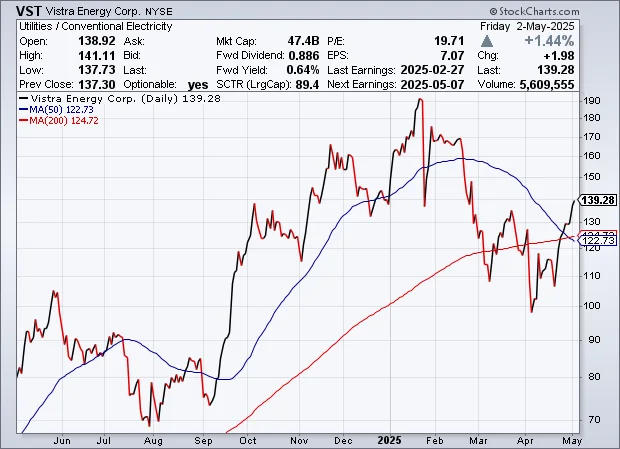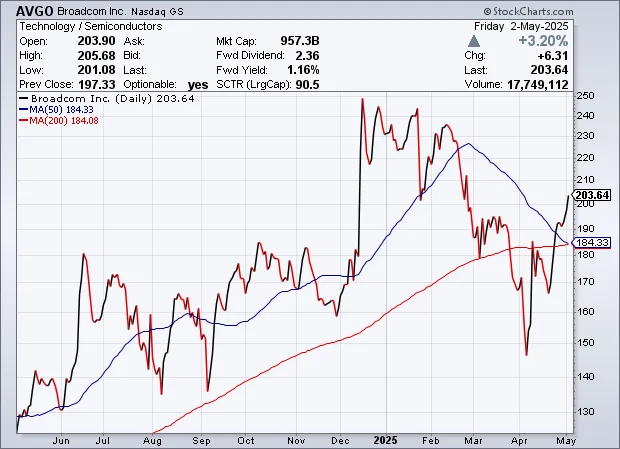Five dividend-paying semiconductor stocks to purchase for profiting from companies that seem strong enough to avert disaster from tariff tumult.
The S&P 500 is on the verge of notching its ninth consecutive advance Friday, May 2, for the first time in more than 20 years, according to Bloomberg. The market’s performance is giving extra weight to President Trump’s comment that tariffs may cause “short-term” pain for Americans but that it will ease as he seeks to ensure “fair trade” to protect and to grow American manufacturing jobs and to reduce the U.S. trade deficit.
The president declared a “national emergency” on April 3 due to existing foreign trade and economic practices, spurring him to enact tariffs to strengthen the international economic position of the United States. Also on April 3, the White House announced that “large and persistent” annual trade deficits for U.S. goods have led to the “hollowing out” of America’s manufacturing base and created disincentives to increase domestic production. Other ill effects include undermining “critical supply chains,” creating dependence on foreign adversaries and leaving the U.S. defense-industrial base vulnerable to disruption, the president cautioned.
Five Dividend-paying Semiconductor Stocks to Purchase: Perry’s Pick
Reports on Friday, May 2, that China is considering starting trade negotiations with the United States and employment data is improving more than analysts expected further lifted stocks, said Bryan Perry, the head of the Cash Machine investment newsletter and the Hi-Tech Trader advisory service. The market is reacting positively to a potential trade deal between the United States and China, a favorable U.S. job market and “tame” inflation, Perry advised his Hi-Tech Trader advisory service subscribers.
Plus, first-quarter earnings are also coming in above forecast for roughly 70% of companies that have reported thus far, Perry continued. Perry opted to recommend a dividend-paying semiconductor stock on Friday, May 2, that has fallen in price by 15.85% in the past six months.

Bryan Perry heads Cash Machine and Hi-Tech Trader.
The semiconductor stock, Santa Clara, California-based Nvidia Corp. (NASDAQ: NVDA), carries a bullish artificial intelligence (AI) rating. In light of its pullback and already announcing a $5-plus billion charge to its financial results, Perry wrote that it is time to buy the stock again with the market resuming its support for big-capitalization technology stocks in the past week. He predicted that momentum would be “sustainable” going forward.
Five Dividend-paying Semiconductor Stocks to Purchase: NVDA
Nvidia neared its 50-day moving average when it rose 2.59% on Friday, May 2, by closing at $114.50. The share price looks like it may recover to once again reach its 200-day moving average of $125, Perry wrote to his Hi-Tech Trader advisory service subscribers.

Chart courtesy of stockcharts.com.
Semiconductor companies comprise $144 billion of the $406 billion in data center system spending, according to Gartner. That semiconductor data center spending is expected to rise to $179 billion by calendar year 2028, based on a projected 12.5% compound annual growth rate (CAGR), the research firm wrote.
The global semiconductor industry pulled in $335 billion in revenue in 2015, according to the Gilder Technology Report. In 2025, it will more than double to nearly $690 billion, the Gilder Technology Report added.

Paul Dykewicz poses with George Gilder, of Gilder’s Technology Report and Gilder’s Moonshots.
Semiconductor and data center giants create massive barriers for newcomers, according to the Gilder’s Moonshots advisory service. The immense cost and complexity of building advanced fabs and data centers lock out smaller players, leaving the industry reliant on an increasingly narrow set of dominant firms, the report continued.
Nvidia Remains a Strong Buy Despite Geopolitical Headwinds
Privately-held Huawei’s Ascend 910C and 910D semiconductor chips have generated notable momentum inside China, largely driven by geopolitical forces rather than technical superiority. Although Huawei has made meaningful progress in advancing domestic AI hardware, detailed analysis shows that those semiconductor chips continue to lag behind Nvidia’s offerings in critical areas such as software ecosystem maturity, memory bandwidth, multi-GPU scalability, manufacturing efficiency and system-level performance for large AI model training, according to Gilder’s Technology Report.
The adoption of Huawei’s chips within China is primarily a result of U.S. export restrictions that limit access to Nvidia’s most advanced graphic processing units (GPUs). While this policy shift has helped Huawei gain domestic traction, it does not signal a change in the global competitive landscape, where Nvidia’s architecture, software platform and manufacturing partnerships remain unmatched. The U.S. restrictions are more immediately impactful to Nvidia’s short-term China revenues, but they also reinforce Nvidia’s long-term opportunity to serve Western markets that are aggressively expanding AI infrastructure independent of China, Gilder’s Technology Report continued.
Nvidia’s Hopper architecture (H100) and forthcoming Blackwell architecture (B100) continue to extend its technical leadership. The company’s ecosystem advantage through CUDA, cuDNN and full-stack AI tools remains a critical differentiator that Huawei and other competitors cannot replicate in the near term, Gilder’s Technology Report advised its subscribers.
“For investors, the concerns surrounding Huawei’s emergence are overstated when considered in a global context,” Gilder’s Technology Report wrote. “Nvidia’s fundamentals remain strong, its innovation pipeline is robust and secular AI infrastructure growth will continue to drive substantial demand across unrestricted regions. Short-term volatility from export restrictions offers an opportunity rather than a risk. In conclusion, Nvidia remains a strong buy based on its unmatched technological leadership, expanding global AI infrastructure demand and enduring ecosystem dominance.”
Five Dividend-paying Semiconductor Stocks to Purchase: Raydium Semiconductor
Taiwan-based Raydium Semiconductor (TW 3592) produces integrated circuit “drivers” for display panels, both traditional LCDs (liquid crystal display) and the OLED (organic light emitting diode) devices that offer advantages such as higher contrast ratios and better viewing angles. OLEDs are suitable for almost all applications, ranging from portable devices such as watches, phones and laptops to big ones like televisions, computer monitors and digital billboards. However, OLED also has disadvantages, such as a limited lifetime and vulnerability to humidity. The pluses are why an OLED television can cost three times as much as an LCD.
The display drivers power and controls a device by helping an operating system communicate information use such as screen resolution, safe and available power and more. Displays are a big part of Raydium’s market and account for much of its revenue volatility during the past decade. However, the company adds a strong cyclical element to its share price. That’s partly why Raydium’s revenue has been on the rise.
Founded in 2003 on core semiconductor technology, Raydium reported plans to provide innovation, transformation and research and development (R&D) advances. The company also seeks to pioneer the semiconductor industry in undertaking strategic planning for emerging trends, technologies and products.
Investors who are wary about owning shares in a foreign company do not need to personally become experts, as long as they access guidance from those who follow it closely. One source is Gilder’s Technology Report. Gilder and his team of senior analysts track Raydium Semiconductor and other foreign technology companies, along with semiconductor stocks in the United States.

Chart courtesy of yahoofinance.com.
Even though technology stocks generally were hit hard initially as tariffs and economic concerns among consumers and business leaders arose, the top companies may offer investors a chance to enjoy a rebound. Seek companies well ahead of the pack and built to widen the lead with each lap of innovation, said Gilder, who heads the Gilder’s Technology Report investment newsletter and the Gilder’s Moonshots advisory service.
“Technology leaders will pull away like Secretariat in the homestretch at the Belmont; also-rans will fade like Sham, the next-best horse during the 1973 racing season,” according to Gilder’s Technology Report.
Five Dividend-paying Semiconductor Stocks to Purchase: VST
The five dividend-paying semiconductor stocks to consider purchasing include Irving, Texas-based Vistra Corp. (NYSE: VST). One fan of the company and its prospects is Mark Skousen, PhD, who heads the TNT Trader advisory service and the Forecasts & Strategies investment newsletter.
He has recommended Vistra in the past and is doing so again now. He praised the Fortune 500 company’s integrated retail electricity and power generation business that provides essential resources to customers, businesses and communities from California to Maine.
One of the reasons it can do this is that it provides multiple forms of energy, from natural gas, coal, solar and even nuclear. Vistra even has battery storage facilities, which are key when providing electricity.
“We remain believers that nuclear energy is going to be increasingly adopted around the world as the safest and cleanest way to provide for our energy needs in this new, AI-powered world,” Skousen wrote to his TNT Trader advisory service subscribers.
The company is liked by billionaire investors, with 25 of them currently heavily invested, Skousen continued. Possibly the most famous investor could be Senator Nancy Pelosi, who is also an owner of Vistra stock with her husband, Paul, who manages money.
Vistra’s financial numbers look promising, Skousen opined. The company has a price/earnings (P/E) ratio of just 18, along with an earnings per share (EPS) of a $7.00 a share. Its earnings call is next week, and the average price target of analysts is $163, which would be roughly a 25% gain from its current price.
Skousen also cited Vistra’s payment of a modest dividend as an additional plus.

Mark Skousen leads the Forecasts & Strategies investment newsletter and TNT Trader.
Vistra, with its robust energy portfolio tailored for data center demands, and Vertiv (NYSE: VRT), with its advanced thermal management systems to deal with the massive heat generated by AI, will more than recover from the recent market drop, said Robert Castellano, a senior analyst with Gilder’s Technology Report. Tech stocks were among those that fell the most but later recovered strongly, too, he added.

Chart courtesy of stockcharts.com.
Five Dividend-paying Semiconductor Stocks to Purchase: TSM
President Trump joined Taiwan Semiconductor Manufacturing Company (NYSE: TSM) CEO C.C. Wei on March 4 to announce a historic $100 billion investment by TSMC in its Arizona-based semiconductor chips manufacturing operation — the largest foreign direct investment in U.S. history. TSM is another dividend-paying semiconductor company.
The huge investment of TSM, when combined with the company’s prior $65 billion commitment, will fund the construction of three semiconductor fabrication plants, advanced packaging facilities and a research and development center. The expansion is expected to create tens of thousands of high-tech, high-paying jobs, positioning Arizona as a key production site in the global semiconductor industry.
The jobs created at TSM will need highly skilled workers, ranging from engineers to technicians, researchers and advanced manufacturing specialists. These types of high-wage positions can boost the Arizona economy and provide new job opportunities for its residents, according to Education Forward Arizona, a Section 501(c)(3) advocacy group.
The $100 billion in new investment will go into building five cutting-edge fabrication facilities in Arizona. In total, the announcement brings Taiwan Semiconductor’s investment in Arizona to about $165 billion.
TSM CEO C.C. Wei said that his company would produce many chips to support progress in artificial intelligence (AI) and smartphones.
Five Dividend-paying Semiconductor Stocks to Purchase: Tariff Effect
“President Trump has made it a fundamental objective to bring semiconductor chip manufacturing home to America,” said U.S. Secretary of Commerce Howard Lutnick in a statement when the agreement was announced. Lutnick called TSM the world’s “greatest” semiconductor chip manufacturer.
Since taking office, President Trump has secured nearly $2 trillion in U.S.-based investment and is seeking to build upon it, White House officials said.
Taiwan Semiconductor is also a major contract manufacturer of computer chips for other companies. Its headquarters and main operations are located in Hsinchu, Taiwan.
TSM is in a sweet spot, since China’s leaders don’t want to put tariffs on the company, because to them, its Chinese, said Castellano, a semiconductor analyst who is one of the market specialists who helps to guide the Gilder’s Technology Report investment newsletter. President Trump doesn’t want to put tariffs on the company because it is investing more than $100 billion dollars in the United States, Castellano said.
“The time to buy is now,” Castellano counseled. “You can’t time the market.”
Mark Skousen, who heads the Forecasts & Strategies investment newsletter and the TNT Trader advisory service, recommended TSM in the latter on March 19, 2024, when it traded at $135.42, and advised its sale on May 31, 2024, for roughly $148.00, netting a 9.29% gain.
Michelle Connell, the founder and head of Dallas-based Portia Capital Management, is a former semiconductor analyst who said it is tough to buy stocks “when everything is going down.” But money will be made by buying the higher quality names that have a “moat” or competitive edge, Connell counseled.

Michelle Connell heads Portia Capital Management.
Five Dividend-paying Semiconductor Stocks to Purchase: Good Guidance
The company’s first-quarter 2025 earnings beat expectations, and its guidance was also much better than forecast, with second-quarter revenue up 13% quarter over quarter at midpoint versus the 7% predicted by JP Morgan, the investment firm wrote in an April 21 research note.
TSM has maintained its 2025 guidance, which may be an overhang, but the implied second half growth is the slowest in 10 years, which does reflect some caution regarding macro slowdown and tariffs, JP Morgan continued. The biggest positive from the call was that TSM’s Chairman and CEO, Dr. C.C. Wei, dispelled any involvement in a joint venture, technology transfer or IP sharing with any company, possibly Intel (NASDAQ: INTC), leaving an overhang for the stock in the last two months, JP Morgan added.
TSM also indicated that its long-term forecasts for a 20% overall compound annual growth rate (CAGR) and mid-40% AI accelerator CAGR into 2029 remain intact, while keeping its FY capex guidance unchanged, JP Morgan noted. The stock should trade up in the near-term as management cleared the air on any joint venture involvement, although industry analysts may look to EPS estimates amid the market downturn, JP Morgan concluded.

Chart courtesy of stockcharts.com.
Five Dividend-paying Semiconductor Stocks to Purchase: AVGO
The fifth dividend-paying semiconductor stock to buy is Palo Alto, California-based Broadcom Inc. (NASDAQ: AVGO), a global infrastructure technology company that has devoted its more than 60 years of existence to bring its customers innovation, collaboration and “engineering excellence,” its officials said. Broadcom focuses on technologies that connect the world through brands such as LSI, Brocade, CA Technologies, Symantec’s enterprise security business and VMware.
The company seeks to deliver technology and category-leading semiconductor and infrastructure software solutions. It also combines global scale, a broad product portfolio and operational focus to provide its customers with semiconductor and infrastructure software to build and grow successful businesses.
Even better news for price-conscious investors is that Mark Skousen views the stock as “oversold,” and recommended it in his TNT Trader advisory service. Skousen, a free-market economist and Presidential fellow at Chapman University, also has been named one of the top 20 living economists in the world (www.superscholar.org).
“Demand for its semiconductors has stayed high in the midst of growth in the AI sector and dealing with the trade war,” according to the April 15 edition of TNT Trader.
Michelle Connell, a CFA and president and owner of Portia Capital Management, LLC, is another advocate for Broadcom. VMWare, a recent acquisition of AVGO, is now 60% integrated, she told me.
Plus, profitability is increasing from that side of the business too, Connell counseled.
JPMorgan and Oppenheimer both have recently made AVGO one of their top semiconductor picks, she continued.

Chart courtesy of stockcharts.com.
Five Dividend-paying Semiconductor Stocks to Purchase: U.S.-Ukraine Minerals Deal
Among the recent good news for the markets was that the United States and Ukraine entered into a historic agreement on April 30 to launch a “first-of-its-kind partnership” for the reconstruction and long-term economic success of Ukraine, according to a May 1 White House statement about the deal.
The pact is a “fully collaborative partnership” between the United States and Ukraine that will benefit both, the White House continued. This partnership involves the United States taking an economic stake in securing a “free, peaceful and sovereign future” for Ukraine, according to the statement.
“This agreement will also strengthen the strategic partnership between the United States and Ukraine for long-term reconstruction and modernization, in response to the large-scale destruction caused by Russia’s full-scale invasion,” the White House announced. “The Treasury Department and the U.S. International Development Finance Corporation (DFC) will work together with the government of Ukraine to finalize governance and advance this important partnership. The United States’ DFC will work together with Ukraine’s State Organization Agency on Support Public-Private Partnership, both of which are backed by the full faith and credit of their respective nations.”
The White House continued:
- This partnership between the United States and Ukraine establishes a fund that will receive 50% of royalties, license fees and other similar payments from natural resource projects in Ukraine. That money will be invested in new projects in Ukraine, which will generate long-term returns for both the American and Ukrainian peoples.
- As new projects are identified, resources in the fund can be quickly allocated towards economic growth, job creation and other key Ukrainian development priorities.
- Indirect benefits will include a stronger private sector and more robust, lasting infrastructure for Ukraine’s long-term success.
- The partnership will be controlled by a company with equal representation of three Ukrainian and three American board members, who will work together through a collaborative process to make decisions for the allocation of fund resources, such as investment and distributions.
“Importantly, this partnership sends a strong message to Russia — the United States has skin in the game and is committed to Ukraine’s long-term success,” according the statement released by the White House on May 1. “No state, company or person who financed or supplied the Russian war machine will be allowed to benefit from the reconstruction of Ukraine, including participation in projects supported by fund resources.”
Five Dividend-paying Semiconductor Stocks to Purchase: Russia Rackets up Risk
Investors need to be wary of geopolitical risk from tariff tumult to wars. Russia continues to resist President Trump’s efforts to broker a ceasefire and end to its three-year-old invasion of Ukraine. Russia increased the intensity of its fighting in Ukraine and attacks on civilians in what U.S. Secretary of State Marco Rubio called “a very critical week” for peace talks.
The General Staff of the Armed Forces of Ukraine reported that there have been 177 combat clashes in one day, including 91 airstrikes at the positions of “Ukrainian units and settlements.” The fighting comes despite Russian President Vladimir Putin recently announcing a three-day ceasefire to mark the 80th anniversary of World War II Victory Day.
Human rights monitors of the United Nations documented a high intensity of attacks across Ukraine in April, according to the international organization with 193 member states. For example, in the early hours of April 24, Russia launched a large-scale, coordinated attack on Kyiv, the Capitol of Ukraine, and at least eight other regions of the country using scores of munitions and missiles with 44 people requiring hospitalization, the UN reported.
“In one Kyiv location, a powerful missile directly struck a two-story residential building, razing it to the ground,” according to the United Nations. Fires broke out across the city due to falling debris from intercepted missiles.
Similar attacks occurred in several regions, including Kharkiv, Dnipropetrovsk, Zhytomyr, Zaporizhzhia and Kyiv, injuring civilians who included children, according to the UN.
“The scenes of destruction and suffering in Kyiv… reflect a deeply disturbing trend — civilians bearing the brunt of ever more intense and frequent attacks,” said Danielle Bell, head of the UN Human Rights Monitoring Mission in Ukraine (HRMMU).
Between April 1 and 24, Ukraine verified 848 civilian casualties, with 151 killed and 697 injured, a 46% increase compared to the same period last year, according to the UN. The verification process is still ongoing, with casualty numbers expected to rise, it added.
Aside from the military combat in Ukraine and elsewhere in the world, tariffs add to investment risk. A baseline 10% tariff that went into effect on April 5 still remains in place for all affected imports into the United States. President Trump is asserting he is willing to negotiate trade deals with other heads of state. Market observers are watching whether new trade agreements can be reached and how long it will take, as well as whether Russia will continue its three-year invasion of Ukraine despite President Trump’s efforts to end the killing.
Paul Dykewicz, www.pauldykewicz.com, is an award-winning journalist who has written for Dow Jones, the Wall Street Journal, Investor’s Business Daily, USA Today, the Journal of Commerce, Crain Communications, Seeking Alpha, Guru Focus and other publications and websites. Paul can be followed on Twitter @PaulDykewicz, and is the editor and a columnist at StockInvestor.com and DividendInvestor.com. He also serves as editorial director of Eagle Financial Publications in Washington, D.C. In that role, he edits monthly investment newsletters, time-sensitive trading alerts, free weekly e-letters and other reports. Previously, Paul served as business editor and a columnist at Baltimore’s Daily Record newspaper and as a reporter at the Baltimore Business Journal. Plus, Paul is the author of an inspirational book, “Holy Smokes! Golden Guidance from Notre Dame’s Championship Chaplain,” with a foreword by former national championship-winning football coach Lou Holtz. The uplifting book is endorsed by Joe Montana, Joe Theismann, Ara Parseghian, “Rocket” Ismail, Reggie Brooks, Dick Vitale and many other sports figures. To buy signed and specially dedicated copies, call 202-677-4457.




